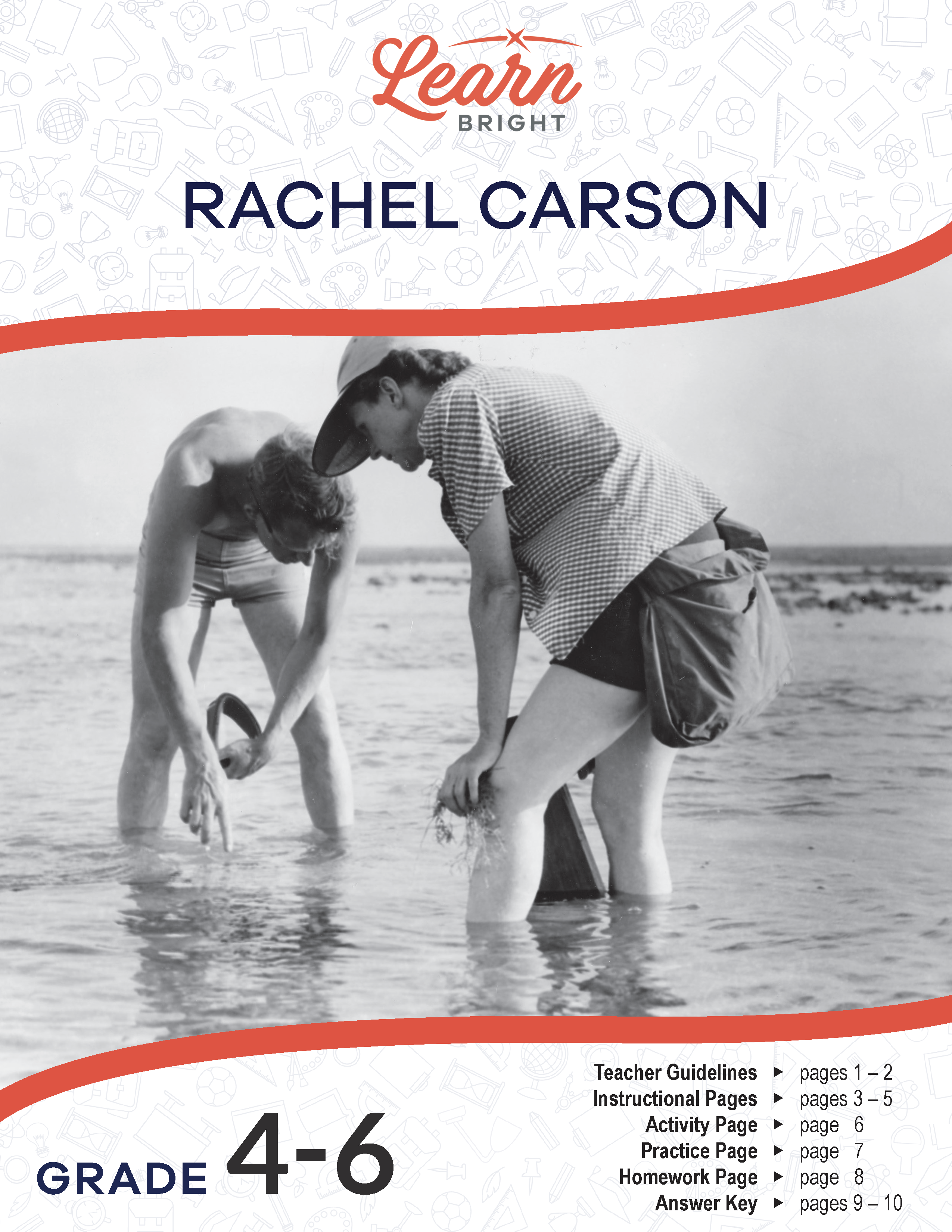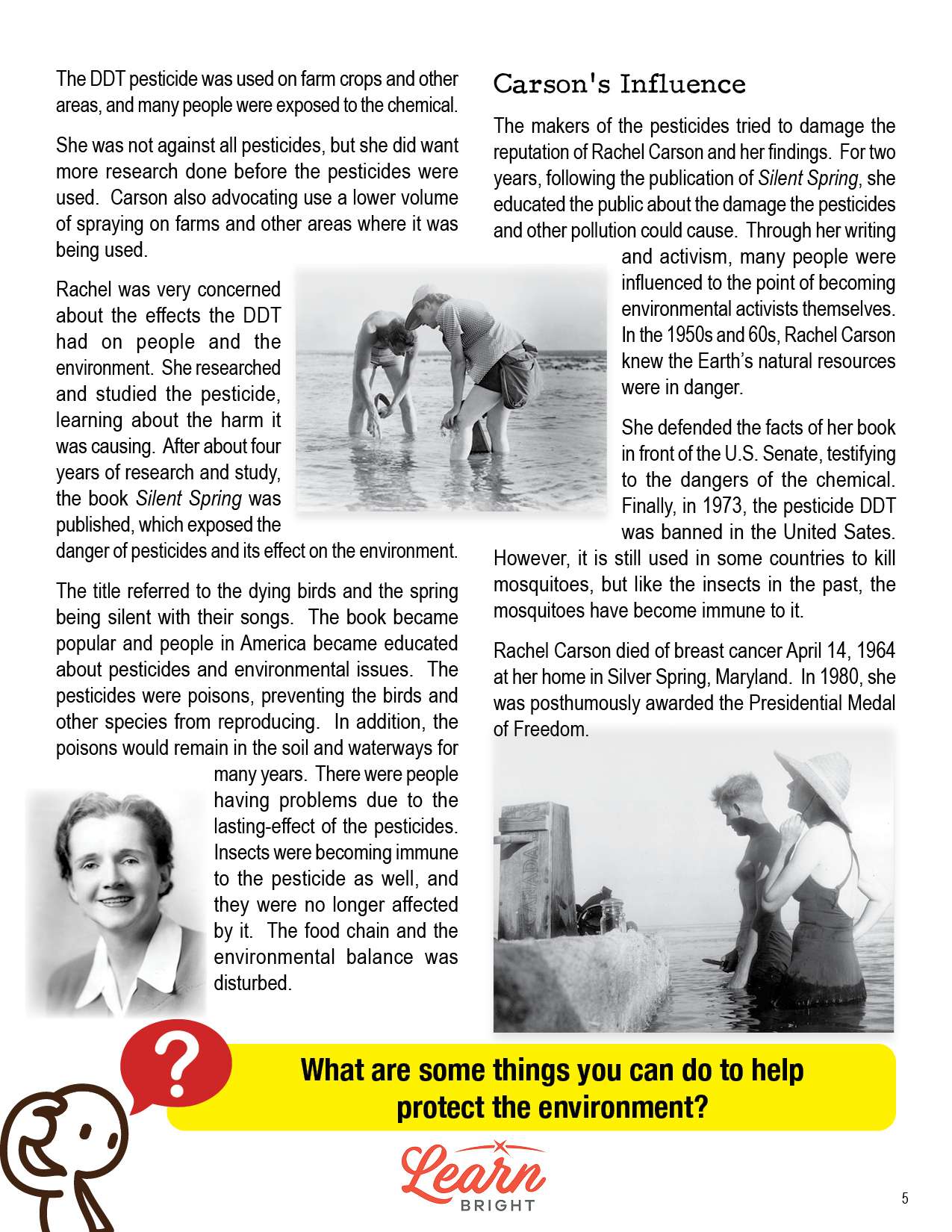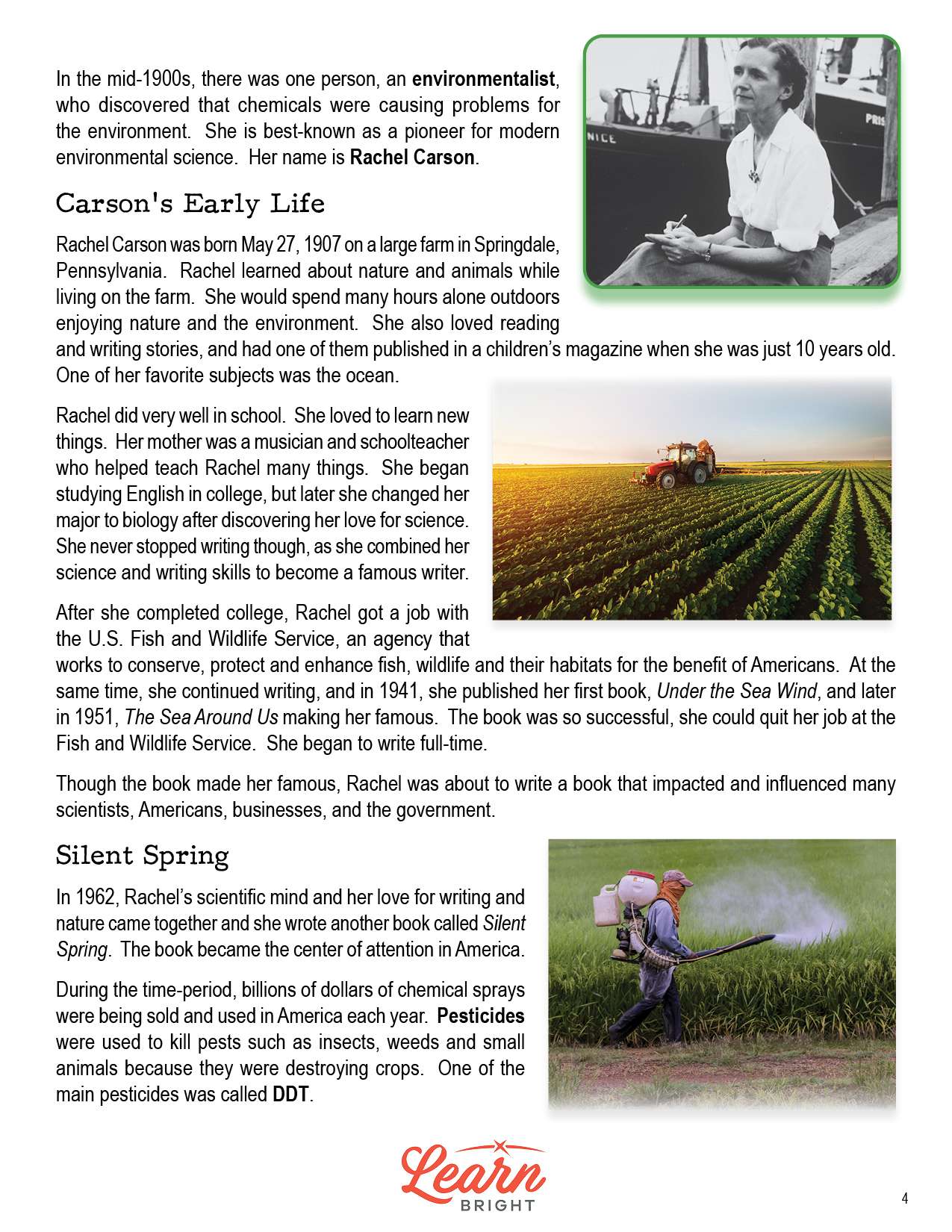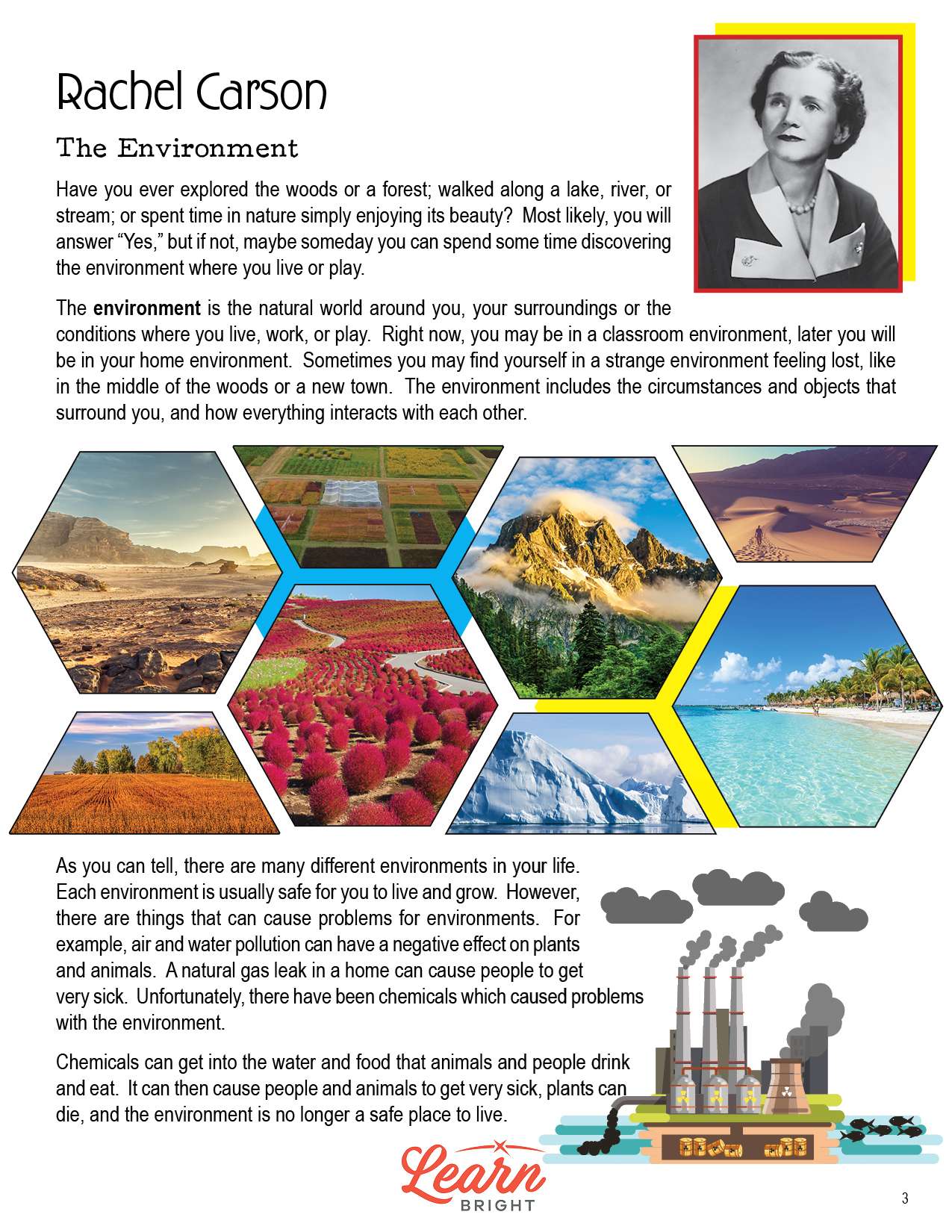Description
What our Rachel Carson lesson plan includes
Lesson Objectives and Overview: Rachel Carson introduces students to writer, scientist, and ecologist Rachel Carson, who played a key role in the birth of environmentalism in the 20th century. At the end of the lesson, students will be able to identify Rachel Carson and list facts about her life and explain her significance in history. This lesson is for students in 4th grade, 5th grade, and 6th grade.
Classroom Procedure
Every lesson plan provides you with a classroom procedure page that outlines a step-by-step guide to follow. You do not have to follow the guide exactly. The guide helps you organize the lesson and details when to hand out worksheets. It also lists information in the orange box that you might find useful. You will find the lesson objectives, state standards, and number of class sessions the lesson should take to complete in this area. In addition, it describes the supplies you will need as well as what and how you need to prepare beforehand. To prepare for this lesson ahead of time, you can pair students for the activity and copy the handouts.
Options for Lesson
Included with this lesson is an “Options for Lesson” section that lists a number of suggestions for activities to add to the lesson or substitutions for the ones already in the lesson. One optional adjustment to the lesson is to present part of the lesson outdoors, asking students to think about the nature around them. You can also ask your students what it would be like if there were no trees, waterways, and more to get them thinking about their natural environment. You could plan to teach this lesson during Earth Day or Week. To add to the lesson activity, you could also display the students’ posters from the lesson activity and have the school vote on which are the best or most creative, most colorful, and more. If you teach older students, you can assign Carson’s book Silent Spring or use excerpts from the book and discuss it during class. Another idea for an additional activity is to invite an environmentalist to speak to your class. You could also take students on a walking field trip through the school’s neighborhood and ask them to point out any environmental problems they may see. Finally, you could let your students explore the U.S. Fish and Wildlife website.
Teacher Notes
The teacher notes page includes a paragraph with additional guidelines and things to think about as you begin to plan your lesson. This page also includes lines that you can use to add your own notes as you’re preparing for this lesson.
RACHEL CARSON LESSON PLAN CONTENT PAGES
The Environment
The Rachel Carson lesson plan includes three content pages. Many people have explored the woods or a forest, walked along a lake or river, or spent time enjoying nature. The environment is what we call the natural world around you, including your surroundings or the conditions in which you live. Students might be in a classroom environment and will later return to their home environment. You might end up in a strange environment sometime, such as the middle of the woods or a new town. Your environment includes the things and circumstances around you and how those things interact with one another.
Everyone experiences many different environments throughout their lives. Many of these environments are safe places to live and grow. However, there are things that can harm the environment, like air and water pollution. Pollution had a negative effect on plants and animals. Natural gas leaks can harm humans. Chemicals can cause many different problems for the environment as well.
Sometimes, chemicals can get into the water and food that people and animals drink and eat. They can cause those people and animals to get sick, plants to die, and make the environment a dangerous place to live.
Rachel Carson, an environmentalist from the mid-1900s, discovered that chemicals cause problems for the environment. We know her today as a pioneer of modern environmental science.
Carson’s Early Life
Rachel Carson was born on a farm in Springdale, Pennsylvania on May 27, 1907. She began learning about nature and animals while living on the farm. She spent lots of time outdoors on her own amongst nature. Rachel was also an avid reader and writer, and published some of her short stories in a children’s magazine at the age of 10. She especially loved the ocean.
Rachel was very good at school and loved to learn. Her mother, a teacher and musician, taught Rachel many things. When Rachel started college, she studied English. However, she later changer her major to biology because of her love of science. Despite choosing to study science, Rachel still loved writing and would later combine the two to become a famous science writer.
After college, Rachel worked for the U.S. Fish and Wildlife Service, a government agency that conserves, protects, and enhances fish, wildlife, and their habitats. She continued writing during this time and published her first book, Under the Sea Wind, in 1941. Her second book, The Sea Around Us, made her famous when she published it in 1951. That book did so well that she quit her Fish and Wildlife Service job to write full-time.
Though The Sea Around Us made her famous, she would later write another book that would impact and influence scientists, Americans, businesses, and the government in a major way.
Silent Spring
Rachel wrote her book Silent Spring in 1962, which brought together her scientific mind, love of writing, and love of nature. This book had a major impact in the United States.
At this time, people sold and used billions of dollars of chemical sprays and pesticides in the United States every year. These pesticides killed pests like insects, weeds, and small animals that killed crops. They called one of the main pesticides used for this purpose DDT. Farmers used DDT on farm crops and other areas, and exposed many people to it.
Rachel did not oppose the use of all pesticides, but wanted to make sure that we had done enough research on them before using them. She also wanted people to use smaller amounts of them when spraying on farms and elsewhere.
Rachel did research on pesticides and was concerned about the effects of DDT on people and the environment. She studied and researched for four years before writing and publishing Silent Spring, which exposed the harmful effects of pesticides and its damaging effects on the environment.
The title of the book referred to birds dying and springtime being silent without their calls. The book was popular and helped many Americans learn about the dangers of pesticides and other environmental issues. Pesticides were poison that prevented birds and other animals from reproducing. The poisons stayed in the soil and waterways for years, causing long-term health effects for people. Insects became immune to the pesticide and were no longer affected by it. The use of pesticides disrupted the food chain and the natural balance of the environment.
Carson’s Influence
The people who made the pesticides tried to discredit Rachel Carson and her work. She spent the two years after the publication of Silent Spring educating the public about the harmful effects of pesticides and pollution. Many people who read her work or heard her speak became environmentalists themselves. She knew, even in the 1950s and 60s, that we’d put the Earth’s natural resources in danger.
Rachel defended her book and research in front of the U.S. Senate and testified about the dangers of DDT. In 1973, the United States banned the use of the chemical DDT. However, some countries still use it to kill mosquitoes. Like other insects, mosquitoes have slowly become immune to it.
Rachel Carson died on April 14, 1964, in Silver Spring, Maryland, of breast cancer. The government awarded her a posthumous Presidential Medal of Freedom in 1980.
RACHEL CARSON LESSON PLAN WORKSHEETS
The Rachel Carson lesson plan includes three worksheets: an activity worksheet, a practice worksheet, and a homework assignment. You can refer to the guide on the classroom procedure page to determine when to hand out each worksheet.
POSTER ACTIVITY WORKSHEET
Students will work with a partner to complete the activity worksheet. Each pair will create a poster encouraging people to protect the environment and to save natural resources. Each poster will include text and images. They will create a draft of the poster before creating the final version.
Students can also work either alone or in larger groups to complete the activity.
CHRONOLOGICAL ORDER PRACTICE WORKSHEET
The practice worksheet asks students to place three sets of events in the correct order from 1-5. They will also define a few lesson vocabulary words.
RACHEL CARSON HOMEWORK ASSIGNMENT
For the homework assignment, students will first fill in the blanks in ten sentences using words from a word bank. Next, they will imagine living during the 1950s and 1960s and will write Rachel Carson a letter about her work protecting the environment.
Worksheet Answer Keys
This lesson plan includes answer keys for the practice worksheet and the homework assignment. If you choose to administer the lesson pages to your students via PDF, you will need to save a new file that omits these pages. Otherwise, you can simply print out the applicable pages and keep these as reference for yourself when grading assignments.









